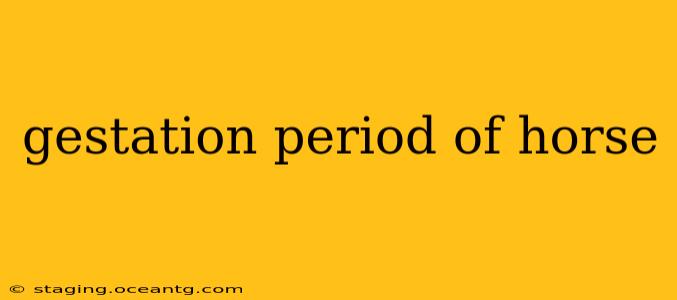The gestation period of a horse, also known as the mare's pregnancy, is a fascinating and crucial aspect of equine reproduction. Understanding this timeframe is vital for breeders and horse owners alike, allowing for proper planning and management of the mare and foal. This comprehensive guide delves into the intricacies of equine gestation, providing you with a detailed understanding of the process and answering frequently asked questions.
How Long is a Horse's Gestation Period?
The average gestation period for a horse is approximately 335 to 345 days, or roughly 11 months. However, it's important to note that this is just an average; variations can occur. Some mares may have shorter or longer gestation periods, falling within a range of 320 to 360 days. Several factors can influence this variation, which we'll explore further below.
What Factors Can Affect a Mare's Gestation Period?
Several factors can influence the length of a mare's gestation period:
- Breed: Certain horse breeds might exhibit slightly longer or shorter gestation periods compared to others. While the differences are usually minimal, breed-specific averages may exist.
- Foal Sex: Studies have shown a slight tendency for mares carrying male foals to have slightly longer gestation periods compared to those carrying female foals. However, this difference is often insignificant in practical terms.
- Nutritional Status: A mare's nutritional intake plays a significant role. Malnutrition can lead to complications and potentially affect gestation length. Proper nutrition is crucial for a healthy pregnancy.
- Stress Levels: Environmental stressors or management practices can impact hormone levels, potentially influencing the gestation period. Minimizing stress is essential for a successful pregnancy.
- Twin Pregnancy: Carrying twins significantly shortens the gestation period. Twin pregnancies are more common in some breeds than others and present a higher risk of complications.
What are the Stages of Equine Gestation?
Equine gestation can be broadly divided into three trimesters:
- First Trimester (Months 1-3): This period is characterized by rapid embryonic development. The embryo implants in the uterus, and vital organ systems begin to form. Many pregnancy losses occur during this stage, often undetected.
- Second Trimester (Months 4-6): The fetus grows significantly during this period, and the mare's abdomen starts to visibly expand. This is a crucial stage for fetal growth and development.
- Third Trimester (Months 7-11): The final trimester involves continued fetal growth and preparation for foaling. The mare's udder begins to develop, and she will show signs of approaching labor.
What are the Signs of Approaching Foaling?
As the gestation period nears its end, mares exhibit several signs indicating approaching foaling:
- Udder Development: The udder will become visibly enlarged, and milk production will begin.
- Waxing of the Teats: A waxy substance may appear on the mare's teats a few days before foaling.
- Relaxation of the Sacroiliac Ligaments: The ligaments connecting the sacrum and ilium become more relaxed, allowing for easier passage of the foal.
- Behavioral Changes: Mares might become restless, pacing, and exhibiting nesting behaviors.
How Can I Track My Mare's Gestation?
Accurate tracking of a mare's gestation is essential. Veterinarians typically use ultrasound scans to confirm pregnancy and monitor fetal development. Regular veterinary checkups are recommended throughout the gestation period to ensure the mare's health and the foal's well-being.
Can a Horse's Gestation Period Be Induced?
While veterinary intervention might be necessary in some cases, inducing foaling is generally discouraged unless there are compelling medical reasons. Induced foaling can increase the risk of complications for both the mare and the foal.
In Conclusion
The gestation period of a horse is a complex process influenced by various factors. Understanding this period, including its average length and potential variations, allows for responsible horse management and care, maximizing the chances of a healthy pregnancy and successful foaling. Regular veterinary care and monitoring are crucial for ensuring a positive outcome for both the mare and her foal.
